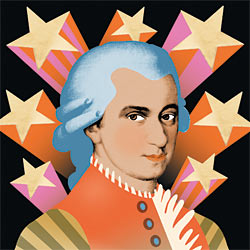
Mozart is the paper doll of composers, always available to switch costume and identity, to mix a bit of one with a scrap of another. There’s the moody proto-romantic Wolfgang in rolled-up shirtsleeves, begetting generations of tormented geniuses. There’s monumental Wolfgang in timeless robes, standing at the apex of human achievement. There’s Classical Wolfgang in powdered wig and brocaded waistcoat; bearded Wolfgang, the progenitor of avant-garde modernism, wearing professor’s tweed; and Wolfgang the entertainer, sporting tattoos and distressed leather. That perpetual adaptiveness is what fuels Mostly Mozart, which has been evolving erratically since 1966. Once a tired summer ritual, the festival has been enjoying a renewed bout of vigor thanks partly to its music director, Louis Langrée, and partly to Mozart’s mutability, which makes it possible to follow his influence down all sorts of byways. This year finds him arm-in-arm with Haydn and Mendelssohn, plus a scattering of less obvious figures. The festival now boasts a composer-in-residence—this year it’s John Adams, whose opera A Flowering Tree received its local premiere last week. (For an online review, click here.)
Some attempts at making connections strain good will. The pianist and conductor Pierre-Laurent Aimard tried valiantly to lend some Classical-era cred to the avant-garde iconoclast Karlheinz Stockhausen by leading the Chamber Orchestra of Europe in his 1953 Kontra-Punkte. Aimard offered a persuasive if apologetic introduction (“You may not love this piece,” he warned), emphasizing the counterpoint, the gamesmanship, and the satisfying lucidity of form that, he said, resembled Haydn’s. Then the music began and the links dissolved. I can imagine Mozart sitting at the piano and improvising a blistering parody of Stockhausen’s skittering melodies and nattering outbursts, which barely speak to the 21st century, let alone the eighteenth.
The festival, like its namesake, weaves back and forth between high purpose and buoyancy, between lightness and loftiness—nowhere more deftly than in Langrée’s opening performance of the “Jupiter” Symphony. He is a very fine conductor whose affinity for Mozart is completely unforced, who caresses a melody with a musketeer’s panache and keeps the beats skimming over the foam. Opera was never far from Mozart’s mind for long, and under Langrée’s direction, vivid characters twine their lyric way through the symphonies.
Langrée on the podium is palpably having a good time. He conducts with a sybaritic grin, frequently reaching out with both arms as if to enfold the orchestra, instruments and all, in a warm embrace. That mix of meticulousness and joy is infectious; the musicians, who shuttle relentlessly between too few rehearsals and too many concerts, sound as if their job were a form of play. It is, of course, but the orchestral world is so afflicted with sobriety that it’s easy to forget.
Langrée had competition in the exuberance department from Yannick Nézet-Séguin, a conductor so small and springy that he reminded me of a Spaldeen. I half expected him to rebound off the podium and go hurtling toward the ceiling. His barely contained energy jumped to the orchestra, which produced a hectic, occasionally untidy, and jubilant performance of Mendelssohn’s “Italian” Symphony.
What’s remarkable about that freshness is that it’s practically become routine. Seven years into his tenure, Langrée no longer feels the need to reinvent the festival every year. There has always been a frustrating disconnect between a musical history that is often described as a constant state of revolution and a concert world terrified of change. Mostly Mozart shows that the two can cohabit gracefully. Centered on the past and bound by self-imposed constraints, the festival has nevertheless found a way to grow young again.
Mostly Mozart
Lincoln Center.
Through August 22.
